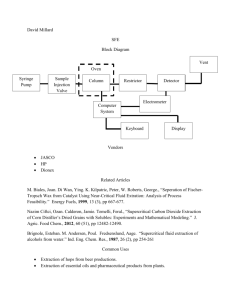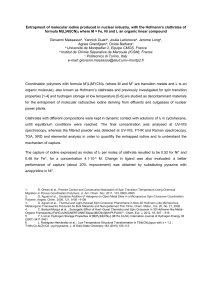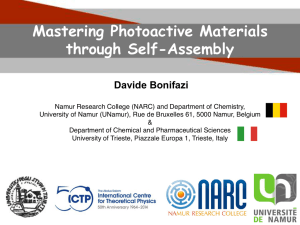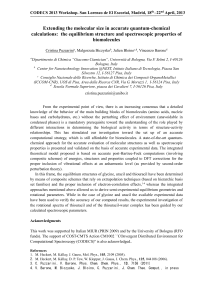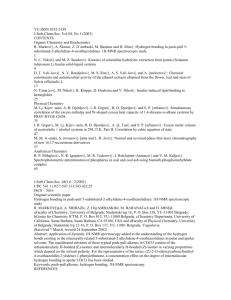JSC-04
advertisement
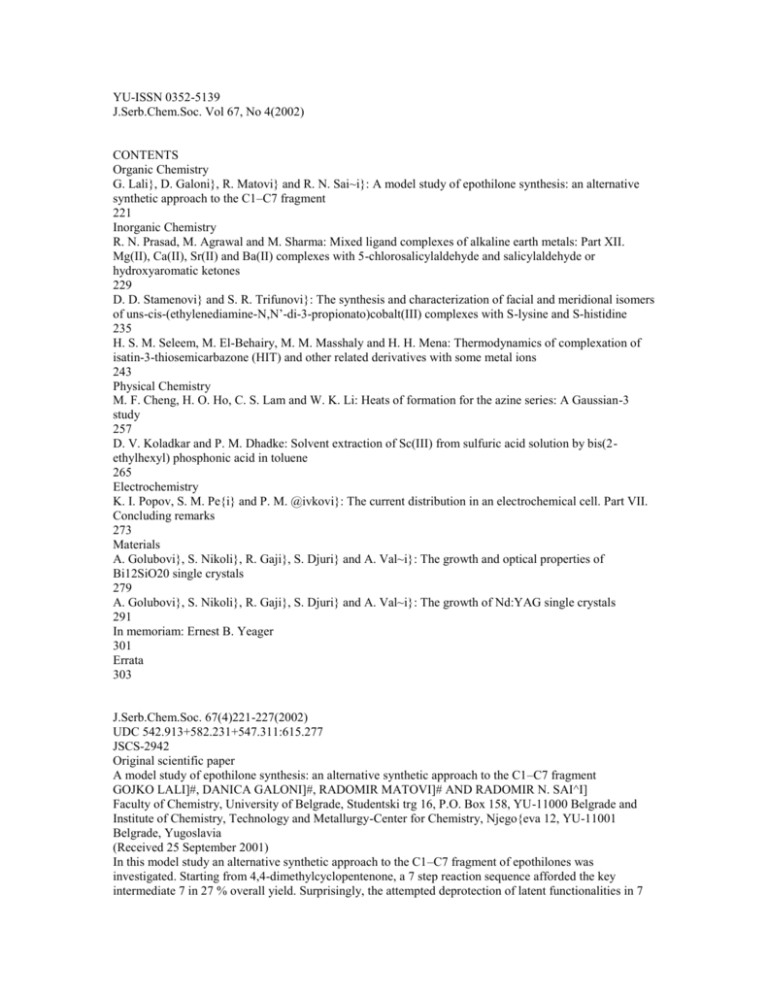
YU-ISSN 0352-5139
J.Serb.Chem.Soc. Vol 67, No 4(2002)
CONTENTS
Organic Chemistry
G. Lali}, D. Galoni}, R. Matovi} and R. N. Sai~i}: A model study of epothilone synthesis: an alternative
synthetic approach to the C1–C7 fragment
221
Inorganic Chemistry
R. N. Prasad, M. Agrawal and M. Sharma: Mixed ligand complexes of alkaline earth metals: Part XII.
Mg(II), Ca(II), Sr(II) and Ba(II) complexes with 5-chlorosalicylaldehyde and salicylaldehyde or
hydroxyaromatic ketones
229
D. D. Stamenovi} and S. R. Trifunovi}: The synthesis and characterization of facial and meridional isomers
of uns-cis-(ethylenediamine-N,N’-di-3-propionato)cobalt(III) complexes with S-lysine and S-histidine
235
H. S. M. Seleem, M. El-Behairy, M. M. Masshaly and H. H. Mena: Thermodynamics of complexation of
isatin-3-thiosemicarbazone (HIT) and other related derivatives with some metal ions
243
Physical Chemistry
M. F. Cheng, H. O. Ho, C. S. Lam and W. K. Li: Heats of formation for the azine series: A Gaussian-3
study
257
D. V. Koladkar and P. M. Dhadke: Solvent extraction of Sc(III) from sulfuric acid solution by bis(2ethylhexyl) phosphonic acid in toluene
265
Electrochemistry
K. I. Popov, S. M. Pe{i} and P. M. @ivkovi}: The current distribution in an electrochemical cell. Part VII.
Concluding remarks
273
Materials
A. Golubovi}, S. Nikoli}, R. Gaji}, S. Djuri} and A. Val~i}: The growth and optical properties of
Bi12SiO20 single crystals
279
A. Golubovi}, S. Nikoli}, R. Gaji}, S. Djuri} and A. Val~i}: The growth of Nd:YAG single crystals
291
In memoriam: Ernest B. Yeager
301
Errata
303
J.Serb.Chem.Soc. 67(4)221-227(2002)
UDC 542.913+582.231+547.311:615.277
JSCS-2942
Original scientific paper
A model study of epothilone synthesis: an alternative synthetic approach to the C1–C7 fragment
GOJKO LALI]#, DANICA GALONI]#, RADOMIR MATOVI]# AND RADOMIR N. SAI^I]
Faculty of Chemistry, University of Belgrade, Studentski trg 16, P.O. Box 158, YU-11000 Belgrade and
Institute of Chemistry, Technology and Metallurgy-Center for Chemistry, Njego{eva 12, YU-11001
Belgrade, Yugoslavia
(Received 25 September 2001)
In this model study an alternative synthetic approach to the C1–C7 fragment of epothilones was
investigated. Starting from 4,4-dimethylcyclopentenone, a 7 step reaction sequence afforded the key
intermediate 7 in 27 % overall yield. Surprisingly, the attempted deprotection of latent functionalities in 7
failed, indicating the incompatibility of the ethoxyethyl protective group with the reaction conditions
employed.
Keywords: epothilones, epoxides, enol ethers, alkylations, Lewis acids.
REFERENCES
1. Isolation and structure elucidation: a) G. Hofle, N. Bedorf, K. Gerth, H. Reichenbach, (GBF), DE-B 4
138 042, 1933. C. A. 120 (1993) 52841; b) G. Hofle, N. Bedorf, H. Steinmetz, D. Schomburg, K. Gerth, H.
Reichenbach, Angew. Chem. Int. Ed. Eng. 35 (1996) 1567
2. For review articles on epothilones, see: a) K. C. Nicolaou, F. Roschangar, D. Vourloumis, Angew.
Chem. Int. Ed. Eng. 37 (1998) 2015; b) R. E. Taylor, J. Org. Chem. 64 (1999) 7224
3. For syntheses prior to 1998, see reference 2a; for some recent examples, see: a) C.B. Lee, T.–C. Chou,
X.–G. Zhang, Z.–G. Wang, S.D. Kuduk, M.D. Chappel, S.J. Stachel, S.J.Danishefsky, J. Org. Chem. 65
(2000) 6525; b) D. Schinzer, A. Bauer, J. Schieber, Chem. Eur. J. 5 (1999) 2492; c) J. D. White, R. G.
Carter, K. F. Sundermenn, J. Org. Chem. 64 (1999) 684; d) R. E. Taylor, Y. Chen, Org. Lett. 3 (2001); e) J.
Mulzer, A. Mantoulidis, E. Ohler, J. Org. Chem. 65 (2000) 7456; f) D. Sawada, M. Kanai, M. Shibasaki, J.
Am. Chem. Soc. 122 (2000) 10521, and references therein
4. a) G. Lali}, @. Petrovski, D. Galoni}, R. Matovi}, R. N. Sai~i}, Tetrahedron Lett. 41 (2000) 763; b) G.
Lali}, @. Petrovski, D. Galoni}, R. Matovi}, R. N. Sai~i}, Tetrahedron 57 (2001) 583
5. a) D. Pauley, F. Anderson, T. Hudlicky, Org. Synth. Coll. Vol. 8, p. 208; b) P. D. Magnus, M. S. Nobbs,
Synth. Commun. 10 (1980) 273
6. G. M. Rubottom, J. M. Gruber, H. D. Jure, D. A. Charleson, Org. Synth. Coll. Vol. 7, p. 282
7. H. Wetter, K. Oertle, Tetrahedron Lett. 25 (1985) 5515
8. L. F. Tietze, T. Eicher, in Reactions and Synthesis in Organic Chemistry Laboratory, University Science
Books, 1989, p. 60
9. E. J. Corey, H. E. Ensley, J. Org. Chem. 38 (1973) 3187
10. G. A. Molander, J. Org. Chem. 51 (1986) 2598
11. A. Fukuzawa, H. Sato, T. Masamune, Tetrahedron Lett. 28 (1987) 4303
12. a) E. J. Corey, A. Venkateswarly, J. Am. Chem. Soc. 94 (1972) 6190; b) G. H. Hakimelahi, Z. A.
Proba, K. K. Ogilvie, Tetrahedron Lett. 22 (1981) 4775
13. E. J. Corey, H. Cho, C. Rucker, D. Hua, Tetrahedron Lett. 22 (1981) 3455.
J.Serb.Chem.Soc. 67(4)229–234(2002)
UDC 546.40+66.063.8:547.572+547.576
JSCS-2943
Original scientific paper
Mixed ligand complexes of alkaline earth metals: Part XII. Mg(II), Ca(II), Sr(II) and Ba(II) complexes with
5-chlorosalicylaldehyde and salicylaldehyde or hydroxyaromatic ketones
R. N. PRASAD, MITHLESH AGRAWAL and MADHULIKA SHARMA
Department of Chemistry, University of Rajasthan, Jaipur – 302004, India
(Received 9 August 2001)
The reactions of alkaline earth metal chlorides with 5-chlorosalicylaldehyde and salicylaldehyde, 2hydroxyacetophenone or 2-hydroxypropiophenone have been carried out in 1 : 1 : 1 mole ratio and the
mixed ligand complexes of the type MLL’(H2O)2 (where M = Mg(II), Ca(II), Sr(II) and Ba(II), HL = 5chlorosalicylaldehyde and HL’ = salicylaldehyde, 2-hydroxyacetophenone or 2-hydroxypropiophenone)
have been isolated. These complexes were characterized by TLC, conductance measurements, IR and 1HNMR spectra.
Keywords: mixed ligand complexes, alkaline earth metals.
REFERENCES
1. P. Pfeiffer, E. Buchholz, O. Bauer, J. Prakt. Chem. 129 (1931) 163 [C. A. 25 (1931) 2131 ]
2.V. I. Kumov, Z. A. Bitovt, A. S. Pesis, Zh. Neorg. Khim. 3 (1958) 1181 [C. A. 53 (1959) 5002i]
3. S. I. Gusev, V. I. Kumov, A. M. Stroganova, Zh. Anal. Khim. 10 (1955) 349 [C. A. 50 (1956) 7654f]
4. K. Clarke, R. A. Cowen, G. W. Gray, E. H. Osborne, J. Chem. Soc. (1963) 245 [C. A. 58 (1963) 642012]
5. W. W. Wendlandt, S. Iflikhar Ali, C. H. Stembridge, Anal. Chim. Acta 30 (1964) 84 [C. A. 60 (1964)
7662]
6. R. N. Prasad, M. Jindal, M. Jain, M. Sharma, J. Ind. Chem. Soc. 67 (1990) 791
7. H. Rosmussen, A. Tenenhouse, Proc. Nat. Acad. Sci 59 (1968) 1364
8. M. N. Hughes, The Inorganic Chemistry of Biological Processes, Wiley, New York, 1972
9. R. N. Prasad, M. Jindal, R. P. Sharma, Curr. Sci. 53 (1984) 1128
10. R. P. Sharma, M. Jindal, R. N. Prasad, Synth. React. Inorg. Met.-Org. Chem. 14 (1984) 501
11. R. N. Prasad, M. Jindal, Synth. React. Inorg. Met.-Org. Chem. 17 (1987) 635
12. R. N. Prasad, M. Jindal, J. Ind. Chem. Soc. 66 (1989) 188
13. R. N. Prasad, M. Jindal, M. Jain; A. Varshney, P. Chand, J. Ind. Chem. Soc. 67 (1990) 91
14. R. N. Prasad, M. Jindal, Synth. React. Inorg. Met.-Org. Chem. 19 (1989) 1
15. R. N. Prasad, M. Jindal, Synth. React. Inorg. Met.-Org. Chem. 19 (1989) 997
16. R. N. Prasad, M. Jindal, M. Sharma, Rev. Roum. Chim. 39 (1994) 65
17. P. R. Ashton, D. E. Fenton, R. N. Prasad, M. Jindal, M. Jain, Inorg. Chim. Acta 146 (1988) 99
18. R. N. Prasad, M. Jindal, M. Jain, J. Ind. Chem. Soc. 67 (1990) 874
19. B. Morosin, Acta Crystallogr. 22 (1967) 315 [C. A. 66 (1967) 59699a]
20. J. J. Sahbari, M. M. Olmstead, Acta Crystallogr. C39 (1983) 208 [C. A. 98 (1983) 117451m]
21. F. J. Hollander, D. H. Templeten, A. Zalkin, Acta Crystrallogr. B29 (1973) 1289 [C. A. 79 (1973)
46559 y]
22. F. J. Hollander, D. H. Templeten, A. Zalkin, Acta Crystallogr. B29 (1973) 1295 [C. A. 79 (1973) 46606
m]
23. F. J. Hollander, D. H. Templeten, A. Zalkin, Acta Crystallogr. B29 (1973) 1303 [C. A. 79 (1973) 46608
p]
24. D. P. Graddon, Coord. Chem. Rev. 4 (1969) 1
25. A. K. Banerjee, B. Mahapatra, D. Prasad, S. K. Roy, J. Ind. Chem. Soc. 62 (1985) 552.
J.Serb.Shem.Soc. 67(4)235–241(2002)
UDC 542.913+547.466.4+546.73:577.112.385+547.78
JSCS-2944
Original scientific paper
The synthesis and characterization of facial and meridional
isomers of uns-cis-(ethylenediamine-N-N’-di-3-propionato)
cobalt(III) complexes with S-lysine and S-histidine
DANIJELA D. STAMENOVI] and SRE]KO R. TRIFUNOVI]
Department of Chemistry, Faculty of Science, University of Kragujevac, P. O. Box 60, 34000 Kragujevac,
Yugoslavia
(Received 14 November 2001)
In the reaction of sodium uns-cis-(ethylenediamine-N-N’-di-3-propionato)-(carbonato)cobaltate(III)
dihydrate and the corresponding amino acid (S-lysine or S-histidine) at 70 ºC, both the theoretically
possible facial and meridional isomers of the uns-cis-(ethylenediamine-N-N’-di-3propionato)(aminoacidato)cobalt(III) complexes were prepared. The complexes were isolated
chromatographically and characterized by elemental analyses, as well as by electron absorption and
infrared spectroscopy.
Keywords: cobalt(III) complexes, ethylenediamine-N-N’-di-3-propionato ligand, S-lysine, S-histidine.
REFERENCES
1. D. J. Radovanovi}, Coord. Chem. Rev. 54 (1984) 159
2. T. J. Sabo, S. R. Trifunovi}, J. Serb. Chem. Soc. 61 (1996) 1179
3. (a) T. J. Sabo, S. R. Grguri}, D. M. Mini}, S. R. Trifunovi}, J. Coord. Chem. 44 (1998) 47
(b) S. R. Grguri}, S. R. Trifunovi}, T. J. Sabo, J. Serb. Chem. Soc. 63 (1998) 669
(c) S. R. Trifunovi}, J. M. Di{i}, T. J. Sabo, Synth. React. Inorg. Met-org. Chem. 29 (1999) 1673
4. @. Lj. Te{i}, S. R. Grguri}, S. R. Trifunovi}, D. M. Milojkovi}, T. J. Sabo, J. Plan. Chrom. 10 (1997)
457
5. H. Kawaguchi, N. Maruyama, T. Ama, T. Yasui, Bull. Chem. Soc. Jpn. 65 (1984) 175
6. R. L. Fanshawe, A. G. Blackman, Inorg. Chem. 34 (1955) 421
7. A. G. Blackman, C. R. Clark, R. L. Fanshawe, XXXII Int. Conf. on Coordination Chemistry, Santiago de
Chile (1997) p. 72
8. M. Okabayashi, K. Igi, J. Hidaka, Bull. Chem. Soc. Jpn. 52 (1979) 753
9. K. Akamatsu, T. Komorita, Y. Shimura, Bull. Chem. Soc. Jpn. 55 (1982) 140
10. K. Akamatsu, T. Komorita, Y. Shimura, Bull. Chem. Soc. Jpn. 55 (1982) 2390
11. D. J. Radanovi}, M. I. Djuran, V. D. Mileti}, R. R. Parijez, J. Serb. Chem. Soc. 50 (1985) 99
12. (a) F. Basolo, C. J. Ballhausen, J. Bjerrum, Acta Chem. Scand. 9 (1955) 810
(b) Y. Shimura, R. Tsuchida, Bull. Chem. Soc. Jpn. 29 (1956) 311
13. M. B. ]elap, S. R. Niketi}, T. J. Janji}, V. N. Nikoli}, Inorg. Chem. 6 (1967) 2063
14. K. Nakamoto, Infrared and Raman Spectra of Inorganic and Coordination Compounds, Wiley, New
York, 1986
15. H. Nazakawa, H. Ohtsuru, H. Yoneda, Bull. Chem. Soc. Jpn. 60 (1987) 525
16. D.J. Garnett, D.W. Watts, Inorg. Chem. 8 (1974) 293.
J.Serb.Chem.Soc. 67(4)243–256(2002)
UDC 541.132+536.7:547.496.3+54-71-036
JSCS-2945
Original scientific paper
Thermodynamics of complexation of isatin-3-thiosemicarbazone (HIT) and other related derivatives with
some metal ions
H. S. M. SELEEM*, M. EL-BEHAIRY, M. M. MASHALY and H. H. MENA
Chemistry Department, Faculty of Education, Ain Shams University, Roxy, Cairo, Egypt
(Received 12 September, revised 6 December 2001)
Proton-ligand formation constants of isatin-3-thiosemicarbazone (HIT) ; N-acetylisatin-3thiosemicarbazone (HAIT) and 5-(p-nitrobenzoyl)-1,2,4-triazino[5,6-b]indole-3-thione (HBITr) ligands and
their corresponding metal-ligand formation constants with Mn2+, Fe3+, Co2+, Ni2+, Cu2+, Zn2+, Cd2+,
UO22+ and Th4+ ions were determined pH-metrically at 10, 20, 30 and 40 ºC in 75 %(v/v) ethanol–water.
The thermodynamic parameters (DG, DH and DS) were also evaluated. It was found that both log K1 and –
DH1, for HIT and HAIT-complexes are somewhat larger than log K2 and –DH2, indicating a change in the
dentate character of these ligands from tridentate (ONN-donors) in 1:1 chelates to bidentate (ON-donors) in
1:2; M:L chelates. In contrast, the values of log K2 and – DH2 for HBITr-complexes are somewhat larger
than log K1 and –DH1, indicating a strong trans-effect for the second coordination. The dissociation
process is non-spontaneous, endothermic and entropically unfavourable while the complexation process is
spontaneous, exothermic and entropically favourable. The thermodynamic parameters were separated into
their electrostatic (el) and non-electrostatic (non) constituents.
Keywords: dissociation, stability constants, thermodynamic parameters, isatin-3-thiosemicarbazone, Nacetylisatin-3-thiosemicarbazone, 5-(p-nitrobenzoyl)-1,2,4-triazino[5,6-b]indole-3-thione.
REFERENCES
1. D. X. West, C. S. Carlson, A. E. Liberta, J. P. Scovill, Trans. Met. Chem. 15 (1991) 283
2. R. S. Varma, I. A. Khan, Indian J. Med. Res. 67 (1978) 315
3. R. S. Varma, W. L. Nobles, J. Pharm. Sci. 64 (1975) 881
4. D. D. Perrin, Top. Curr. Chem. 64 (1976) 181
5. F. Kontz, Sci. Pharm. 41 (1973) 123
6. J. A. Grim, H. G. Petering, Cancer Res. 27 (1967) 1278
7. G. Douheret, Bull. Soc. Chim. Fr. (1968) 3122
8. G. Doleschall, K. Lampert, Acta Chim. Acad. Sci. Hung. 64 (1970) 369
9. R. M. Abdel-Rahman, Pak. J. Sci. Ind. Res. 33 (1990) 520
10. R. Silverstein, G. Bassler, T. Morrill, Spectrometric Identification of Organic Compounds, 5th Ed.,
Wiley, New York (1991)
11. A. Albert, E. P. Serjeant, Ionization Constants of Acids and Basses, Chapman, Hall, Edinburgh (1971)
12. H. M. Irving, H. S. Rossotti, J. Chem. Soc. (1954) 2904
13. A. M. Hassan, F. Taha, A. El-Roudi, M. T. Quenawy, J. Indian Chem. Soc. 73 (1996) 325
14. A. M. Hassan, A. El-Roudi, M. T. Quenawy, Egypt. J. Pharm. Sci. 34 (1993) 253
15. A. A. El-Bindary, A. Z. El-Sonbati, H. M. Kera, Can. J. Chem. 77 (1999) 1305
16. A. T. Ramadan, B. A. El-Shetary, M. S. Abdel-Moez, H. S. Seleem, Acta Chim. Hung. 13 (1993) 25
17. W. Linert, A. Taha, J. Coord. Chem. 29 (1993) 265
18. A. McAuley, G. H. Nancollas, K. Torrance, Inorg. Chem. 6 (1967) 136
19. A. G. Evans, J. C. Evans, B. A. El-Shetary, C. C. Rowlands, P. H. Morgan, J. Coord. Chem. 9 (1979)
19
20. P. George, D. S. McClure, Progress in Inorganic Chemistry, Vol. I, Interscience, New York (1959)
21. A. T. Ramadan, M. A. El-Behairy, A. I. Ismail, M. A. Mahmoud, Monatsh. Chem. 125 (1994) 1171
22. P. Paoletti, A. Vacca, J. Chem. Soc. (1964) 5051
23. C. K. Jorgenson, Acta Chem. Scand. 10 (1956) 887
24. C. Degischer, G. H. Nancollas, J. Chem. Soc. A (1970) 1125
25. G. Anderegg, Helv. Chim. Acta 51 (1968) 185
26. R. G. Pearson, J. Am. Chem. Soc. 85 (1963) 3533
27. G. Klopman, J. Am. Chem. Soc. 90 (1968) 233
28. A. T. Ramadan, M. H. Seada, E. N. Rizkalla, Talanta 30 (1983) 245.
J.Serb.Chem.Soc. 67(4)257–264(2002)
UDC 547.85+542.46
JSCS-2946
Original scientific paper
Heats of formation for the azine series: A Gaussian-3 study
MEI-FUN CHENG, HO-ON HO, CHOW-SHING LAM and WAI-KEE LI
Department of Chemistry, The Chinese University of Hong Kong, Shatin, N.T., Hong Kong
(Received 28 November 2001)
Applying the Gaussian-3 (G3) model and its variant G3(MP2), and using the atomization scheme, the heats
of formation (DHf) at 0 K and 298 K have been calculated for twelve monocyclic azines with the general
formula Nn(CH)6-n, n = 1, 2, …, 6. Upon comparing the calculated results with available experimental
data, it is found that the calculated structural parameters agree very well with the experimental ones.
Additionally, most of the calculated DHf values are well within ±10 kJ mol-1 of the available experimental
data. Thus, it is concluded that the unfavorable accumulation of component errors found in the Gaussian-2
methods is greatly reduced in the G3 models. Also, the calculated DHf values for those azines for which no
experimental data exists should be reliable estimates.
Keywords: azines, heats of formation, Gaussian-3 calculation.
REFERENCES
1. J. Cioslowski, J. Sauer, J. Hetzenegger, T. Kacher, T. Hierstetter, J. Am. Chem. Soc. 115 (1993) 1353
2.S. Creuzet, J. Langlet, Chem. Phys. Lett. 208 (1993) 511
3. Y.-S. Cheung, C.-K. Wong, W.-K. Li, J. Mol. Struct. (Theochem) 454 (1998) 17
4. T.-S. Cheung, C.-K. Law, W.-K. Li, J. Mol. Struct. (Theochem) 572 (2001) 243
5. L. A. Curtiss, K. Raghavachari, G. W. Trucks, J. A. Pople, J. Chem. Phys. 94 (1991) 7221
6. L. A. Curtiss, K. Raghavachari, P. C. Redfern, V. Rassolov, J. A. Pople, J. Chem. Phys. 109 (1998) 7764
7. L. A. Curtiss, K. Raghavachari, P. C. Redfern, V. Rassolov, J. A. Polpe, J. Phus. Chem. A 110 (1999)
4703
8. M. J. Frisch, G. W. Trucks, H. B. Schlegel, G. E. Scuseria, M. A. Robb, J. R. Cheeseman, V. G.
Zakrzewski, J. A. Montgomery, R. E. Stratmann, J. C. Burant, S. Dapprich, J. M. Millam, A. D. Daniels, K.
N. Kudin, M. C. Strain, O. Farkas, J. Tomasi, V. Barone, M. Cossi, R. Cammi, B. Mennucci, C. Pomelli, C.
Adamo, S. Clifford, J. Ochterski, G. A. Petersson, P. Y. Ayala, Q. Cui, K. Morokuma, D. K. Malick, A. D.
Rabuck, K. Raghavachari, J. B. Foresman, J. Cioslowski, J. V. Ortiz, B. B. Stefanov, G. Liu, A. Liashenko,
P. Piskorz, I. Komaromi, R. Gomperst, R. L. Martin, D. J. Fox, T. Keith, M. A. Al-Laham, C. Y. Peng, A.
Nanayakkara, C. Gonzalez, M. Challacombe, P. M. W. Gill, B. G. Johnson, W. Chen, M. W. Wong, J. L.
Andres, M. Head-Gordon, E. S. Replogle and J. A. Pople, GAUSSIAN 98, Revision A.7, Gaussian, Inc.,
Pittsburgh PA, 1998
9. A. Nicolaides, L. Radom, Mol. Phys. 88 (1996) 759
10. S. G. Lias, J. E. Bartmess, J. F. Liebman, J. L. Holmes, R. D. Levin, W. G. Mallard, J. Phys. Chem.
Ref. Data Suppl. No. 1, 1988
11. T. Eicher, S. Hauptmann, The Chemistry of Heterocycles, Springer-Verlag, Stuttgart, 1995
12. S. V. Pai, C. F. Chabalowski, B. M. Rice, J. Phys. Chem. 100 (1996) 5681
13. A. Vogler, R. E. Wright, H. Kunkley, Angew. Chem. Int. Ed. Engl. 19 (1980) 717
14. See, for example, R. Engelke, J. Physl. Chem. 96 (1992) 10789 and references cited therein
15. R. M. Joshi, J. Macromol. Sci. Chem. A18 (1982) 861.
J.Serb.Chem.Soc. 67(4)265–272(2002)
UDC 546.63+66.061+546.226-325:547.533
JSCS-2947
Original scientific paper
Solvent extraction of Sc(III) from sulfuric acid solution by bis (2-ethylhexyl) phosphinic acid in toluene
DEVENDRA V. KOLADKAR and PURSHOTTAM M. DHADKE
Inorganic Chemistry Laboratory, Department of Chemical Technology, University of Mumbai, Matunga,
Mumbai 400019, India
(Received 2 July, revised 30 October 2001)
Liquid-liquid extraction of scandium(III) from sulfuric acid solution using bis(2-ethylhexyl) phosphinic
acid (PIA-8) in toluene has been studied. The extraction of scandium(III) was found to be quantitative with
0.03 M PIA-8 in toluene in the acidic range of 0.1–0.5 M and 6.0–8.0 M H2SO4. The effect of the reagent
concentration and other parameters on the extraction of scandium(III) was also studied. The stoichiometry
of the extracted species of scandium(III) was determined on the basis of the slope analysis method. The
extraction reaction proceeds via the cation exchange mechanism in the H2SO4 concentration range of 0.1–
0.5 M and the extracted species is ScR3.3HR. However, at higher acidity (6.0 M –8.0 M H2SO4) it
proceeds by solvation. The extracted species is HSc(SO4)2.4HR. The temperature dependencies of the
extraction equilibrium constants were examined to estimate the apparent thermodynamic functions (DH,
DS and DG) for the extraction reaction.
Keywords: scandium(III), solvent extraction, bis(2-ethylhexyl) phosphinic acid, sulfate.
REFERENCES
1. Y. Nagaosa, Y. Binghua, Talanta 44 (1997) 327
2. Y. Nagaosa, N. Nonome, J. Chem. Technol. Biotechnol. 69 (1997) 144
3. Y. Nagaosa, Y. Binghua, M. Satake, A. Nomura, K. Horta, Solvent Extr. Ion Exch. 14 (1996) 849
4. P. Zhang, K. Inoue, K. Yoshizaka, H. Tsuyama, Nippon Kagaku Kaishi (1995) 407
5. A. Hinko, T. Hirai, I. Komasawa, J. Chem. Eng. Japan 29 (1996) 1041
6. P. Zhang, K. Inoue, H. Tsuyama, Proc. Symp. Solvent Extr. 1994, pp. 91, 92
7. D. Wang, Y. Li, G. Xu, Solvent Extr. Ion Exch. 14 (1996) 585; A. Hinko, Proc. Symp. Solvent Extr.
1993. pp. 37, 38
8. Kazunobu Kodama, Methods of Quantitative Inorganic Analysis, Japan, p. 345
9. Kazunobu Kodama, Methods of Quantitative Inorganic Analysis, Japan, p. 344
10. M. T. Naik, P. M. Dhadke, J. Chem. Eng. Japan 32 (1999) 366
11. D. F. Pepard, G. W. Mason, J. L. Maier, J. Inorg. Nucl. Chem. 3 (1956) 215
12. I. A. Cotton, G. Wilkinson, Advanced Inorganic Chemistry, A Comprehensive Text, 3rd Ed., Wiley
Interscience Publication, 1972.
J.Serb.Chem.Soc. 67(4)273–278(2002)
UDC 537.31:621.357:541.136
JSCS-2948
Original scientific paper
The current distribution in an electrochemical cell. Part VII.
Concuding remarks
K. I. POPOV1, S. M. PE[I]2 and P. M. @IVKOVI]1
1Faculty of Technology and Metallurgy, University of Belgrade, P. O. Box 35-03, Karnegijeva 4, YU11001 Belgrade and 2EI-[tampana kola d.d., Printed Circuit Board Factory, Bul. Cara Konstantina 80-84,
YU-18000 Ni{, Yugoslavia
(Received 25 July, revised 1 November 2001)
A new method for the determination of the ability of an electrolyte to distrubute uniformly current density
in an electrochemical cell is proposed. It is based on the comparison of the current in cells in which the
electrode edges touch the cell side walls with the current in cells with different electrode edge – cell side
wall distances. The effects of cell geometry, process parameters and current density are discussed and
illustrated using the results presented in the previous papers from this series.
Keywords: metal electrodeposition, electrochemical cell, current distrubution.
REFERENCES
1. H. E. Haring, W. Blum, Trans. Electrochem. Soc. 44 (1923) 313
2. A. H. Hitley, Trans. Electrochem. Soc. 44 (1923) 283
3. L. C. Pan, Trans. Electrochem. Soc. 58 (1930) 423
4. S. Field, Metal Ind. (London) 44 (1934) 614 and J. Electrodepositions Techn. Soc. 9 (1934) 144
5. T. C. Tan, J. Electrochem. Soc. 134 (1987) 3011
6. K. I. Popov, S. K. Ze~evi}, S. M. Pe{i}, Z. S. Stojanovi}, J. Serb. Chem. Soc. 61 (1996) 1225
7. K. I. Popov, S. M. Pe{i}, T. M. Kosti}, J. Serb. Chem. Soc. 64 (1999) 341
8. K. I. Popov, S. K. Ze~evi}, S. M. Pe{i}, J. Serb. Chem. Soc. 60 (1995) 307
9. K. I. Popov, S. K. Ze~evi}, S. M. Pe{i}, J. Serb. Chem. Soc. 61 (1996) 583
10. K. I. Popov, S. M. Pe{i}, T. M. Kosti}, J. Serb. Chem. Soc. 64 (1999) 795
11. K. I. Popov, S. M. Pe{i}, P. M. @ivkovi}, J. Serb. Chem. Soc. 66 (2001) 491.
J.Serb.Chem.Soc. 67(4)279-289(2002)
UDC 546-162+546.87-036.8:548.2:535.004.12
JSCS-2949
Original scientific paper
The growth and optical properties of Bi12SiO20 single crystals
ALEKSANDAR GOLUBOVI]1 , SLOBODANKA NIKOLI]1, RADO[ GAJI]1, STEVAN \URI]2 and
ANDREJA VAL^I]3
1Institute of Physics, Pregrevica 118, P. O. Box 57, YU-11001 Belgrade, 2Faculty of Mining and Geology,
\u{ina 7, P. O. Box 162, YU-11000 Belgrade and 3Faculty of Technology and Metallurgy, Karnegijeva 4,
YU-11000 Belgrade, Yugoslavia
(Received 11 May 2001)
Single crystals of Bi12SiO20 were grown from the melt by the Czochralski technique. The critical crystal
diameter dc = 10 mm and the critical rate of rotation wc = 20 rpm were calculated by equations from the
hydrodynamics of a melt. The rate of crystal growth was experimentally obtained to be 5 mm/h. The crystal
growth was in the [ 111] direction. The lattice parameter a = 1.0096 nm was determined by X-ray powder
diffraction. The reflectance spectra were recorded in the wave numbers range 20–5000 cm-1 at different
temperatures. For all the recorded spectra the values of the vibrational TO and LO modes were found using
the Kramers-Kronig analysis (KKA). Twentyfive TO and LO modes were found at 70 K, and eighteen at
295 K. The obtained results are discussed and compared with published data.
Keywords: bismuth silicon oxide single crystals, Czochralski technique, critical diameter, critical rate of
rotation, optical properties.
REFERENCES
1. J. F. Carvalho, A. C. Hernandes, J. Crystal Growth 205 (1999) 185
2. B. A. Horowitz, F. J. Corbett, Opt. Eng. 17 (1978) 353
3. W. Piekarcyk, M. Swirkowitz, S. Gazda, Mater. Res. Bull. 13 (1978) 889
4. R. C. Troth, J. C. Dainty, Opt. Letters 16 (1991) 53
5. H. Rajbenbach, J. P. Huignard, B. Loiseaux, Opt. Commun. 48 (1983) 247
6. R. C. G. Barnes, J. Crystal Growth 69 (1984) 248
7. L. Boutsikaris, S. Mailis, N. A. Vainos, J. Opt. Soc. Am. B 15 (1998) 1042
8. J. C. Brice, T. M. Bruton, O. F. Hill, F. A. C. Whiffin, J. Crystal Growth 24/25 (1974) 429
9. M. D. Aggarwal, W. S. Wang, J. Choi, J. C. Cochrane, Z. Y. Wang, J. Crystal Growth 137 (1994) 132
10. R. Gopalakrishnan, D. Krishnamurthy, D. Arivuoli, Mater. Chem. Phys. 37 (1994) 90
11. M. T. Santos, J. C. Rojo, L. Arizmendi, E. Diguez, J. Crystal Growth 142 (1994) 103
12. M. T. Santos, J. C. Rojo, A. Cintas, L. Arizmendi, E. Diguez, J. Crystal Growth 156 (1995) 413
13. X. W. Xu, J. Y. Liao, B. F. Shen, P. F. Shao, X. Q. Chen, C. F. He, J. Crystal Growth 133 (1993) 267
14. A. Golubovi}, S. Nikoli}, R. Gaj}, S. \uri}, A. Val~i}, J. Serb. Chem. Soc. 64 (1999) 553
15. R. A. Brown, in Advances in Crystal Growth, P. M. Dryburgh, Ed. Prentice-Hall, Englewood Cliffs,
New York, 1987, p. 41
16. R. Ristorcelli, J. L. Lumley, J. Crystal Growth 116 (1992) 647
17. J. C. Rojo, C. Martin, J. J. Derby, E. Dieguez, J. Crystal Growth 183 (1998) 604
18. J. R. Carruthers, J. Crystal Growth 36 (1976) 212
19. J. C. Brice, T. M. Bruton, O. F. Hill, F. A. C. Whiffin, J. Crystal Growth 24/25 (1974) 129
20. A. R. Tanguary, Jr., S. Mroczkowski, R. C. Barner, J. Crystal Growth 42 (1977) 431
21. S. Maida, M. Hugichi, K. Kodaira, J. Crystal Growth 205 (1999) 317
22. A. S. Somin, A. S. Vasilevskaya, Elektroopticheskie kristalli, Atomizdat, Moskva, 1971, p. 138
23. R. Gopalakrishnan, P. Krishnamurthy, P. Arivouli, P. Ramasamy, Optical Engineering 32 (1994) 682
24. S. \uri}, Nauka Tehnika Bezbednost 1 (1995) 45 (in Serbian)
25. P. Beneventi, R. Capelletti, L. Kovács, Á. Péter, A. M. Lanfredi Manotti, F. Ugozzoli, J. Phys.
Condens. Matter 6 (1994) 6329
26. G. N. Zhizhin, B. N. Mavrin, V. F. Shabanov, Opticheskie kolebatel’nye spektry kristallov, Nauka,
Moskva, 1984, p. 47
27. L. Zengfa, S. Dazhao, S. Sufa, Z. Wanlin, Infrared Phys. 31 (1991) 59
28. A. Golubovi}, R. Gaji}, C. Chen, A. Val~i}, Hemijska industrija 54 (2000) 530
29. A. Golubovi}, R. Gaji}, V. Radojevi}, A. Val~i}, Tehnika: Novi materijali 9 (2000) 17 (in Serbian).
J.Serb.Chem.Soc. 67(4)291–300(2002)
UDC 548.2:546.657:666.293.35
JSCS-2950
Original scientific paper
The growth of Nd: YAG single crystals
ALEKSANDAR GOLUBOVI]1, SLOBODANKA NIKOLI]1, RADO[ GAJI]1, STEVAN \URI]2 and
ANDREJA VAL^I]3
1Institute of Physics, Pregrevica 118, P. O. Box 57, YU-11001 Belgrade, 2Faculty of Mining and Geology,
\u{ina 7, P. O. Box 162, YU-11000 Belgrade and 3Faculty of Technology and Metallurgy, Karnegijeva 4,
YU-11000 Belgrade, Yugoslavia
(Received 17 October, revised 17 December 2001)
Y3Al5O12 doped with 0.8 % wt. Nd (Nd:YAG) single crystals were grown by the Czochralski technique
under an argon atmosphere. The conditions for growing the Nd: YAG single crystals were calculated by
using a combination of Reynolds and Grashof numbers. The critical crystal diameter and the critical rate of
rotation were calculated from the hydrodynamics of the melt. The crystal diameter Dc = 1.5 cm remained
constant during the crystal growth, while the critical rate of rotation changed from wc = 38 rpm after
necking to wc = 13 rpm at the end of the crystal. The value of the rate of crystal growth was experimentally
found to be 0.8–1.0 mm/h. According to our previous experiments, it was confirmed that 20 min exposure
to conc. H3PO4 at 603 K was suitable for chemical polishing. Also, one-hour exposure to conc. H3PO4 at
493 K was found to be suitable for etching. The lattice parameter a = 1.201 (1) nm was determined by Xray powder diffraction. The obtained results are discussed and compared with published data.
Keywords: Czochralski technique, Nd:YAG, growth, single crystal, etching.
REFERENCES
1. T. Fukuda, K. Shimamura, V. V. Kochurikhin, V. I. Chani, B. M. Epelbaum, S. L. Buldochi, H. Takeda,
A. Yoshikava, J. Mat. Science: Mat. Electron. 10 (1999) 571
2. D. Jun, D. Peizhen, X. Jun, J. Crystal Growth 203 (1999) 163
3. S. E. Kapphan, J. Lumin. 83–84 (1999) 411
4. H. A. Wigdor, J. T. Walsh, J. D. B. Featherstone, S. R. Visuri, D. Fried, J. L. Waldvogel, Laser Surg.
Med. 16 (1995) 103
5. R. R. Monchamp, J. Crystal Growth 11 (1971) 310
6. R. F. Belt, R. C. Puttbach, D. A. Lepore, J. Crystal Growth 13–14 (1972) 268
7. C. Belouet, J. Crystal Growth 15 (1972) 188
8. V. J. Fratello, C. D. Brandle, J. Crystal Growth 128 (1993) 1006
9. Y. M. Yu, V. I. Chani, K. Shimamura, T. Fukuda, J. Crystal Growth 171 (1997) 463
10. Y. M. Yu, V. I. Chani, K. Shimamura, K. T. Inaba, T. Fukuda, J. Crystal Growth 177 (1997) 74
11. V. I. Chani, A. Yoshikawa, Y. Kuwano, K. Hasegawa, T. Fukuda, J. Crystal Growth 204 (1999) 155
12. R. S. Feigelson, J. Crystal Growth 79 (1986) 669
13. R. S. Feigelson, Mater. Sci. Eng. B 1 (1988) 67
14. R. S. Feigelson, Tunable Solid State Lasers I, P. Hammerling, A. B. Budgor, A. Pinto, Eds., Springer
Verlag, Berlin-Heidelberg-New York-Tokyo, 1985, pp. 129–142
15. Q. Xiao, J. J. Derby, J. Crystal Growth 139 (1994) 147
16. K. Kitamura, S. Kimura, Y. Miyazawa, Y. Mori, O. Kamada, J. Crystal Growth 62 (1983) 351
17. S. E. Stokowski, M. H. Randles, R. C. Morris, IEEE J. Quantum Electron QE-24 (1988) 934
18. A. Golubovi}, S. Nikoli}, R. Gaji}, S. \uri}, A. Val~i}, J. Serb. Chem. Soc. 64 (1999) 553
19. A. Golubovi}, S. Nikoli}, R. Gaji}, S. \uri}, A. Val~i}, Hem. ind. 53 (1999) 227
20. A. Val~i}, R. Rokni}, S. Nikoli}, Proc. XXII Symp. ETAN in Marines, Zadar, Croatia, 1980, p. 354 (in
Serbian)
21. A. Val~i}, R. Rokni}, S. Nikoli}, IRTC S, Portoro`, Slovenija, Elsevier Publ, 1981, p. 505
22. A. Val~i}, R. Rokni}, S. Nikoli}, Proc. 23. Chem. Symp. of SR Serbia, Belgrade, Yugoslavia, 1987, p.
627 (in Serbian)
23. A. Golubovi}, R. Gaji}, S. Nikoli}, S. \uri}, A. Val~i}, J. Serb. Chem. Soc. 65 (2000) 391
24. M. T. Santos, C. Marin, E. Diequez, J. Crystal Growth 160 (1996) 283
25. J. P. Fontaine, G. P. Extremet, V. Chevrier, J. C. Launay, J. Crystal Growth 139 (1994) 67
26. K. Takagi, T. Fukazawa, M. Ishii, J. Crystal Growth 32 (1972) 89
27. J. R. Carruthers, J. Crystal Growth 36 (1976) 212
28. Q. Xiao, J. J. Derby, J. Crystal Growth 128 (1993) 188
29. D. C. Brown, IEEE J. Quantum Electron. 34 (1998) 2393
30. V. J. Fratello, C. D. Brandle, J. Crystal Growth 128 (1993) 1006
31. M. T. Santos, J. C. Rojo, L. Arizmedni, E. Dieguez, J. Crystal Growth 142 (1994) 103
32. C. D. Brandle, J. Crystal Growth 57 (1982) 65
33. M. Berkowski, K. Iliev, V. Nikolov, P. Peshev, W. Piekarczyk, J. Crystal Growth 83 (1987) 507
34. V. Nikolov, K. Iliev, P. Peshev, J. Crystal Growth 89 (1988) 313
35. V. Nikolov, K. Iliev, P. Peshev, J. Crystal Growth 89 (1988) 324
36. B. Cockayne, J. Crystal Growth 3/4 (1968) 60
37. T. Xu, Z. Wu, W. Peng, Q. Zhen, Z. Xiao, J. Zhou, S. Zhang, S. Xie, C. Huang, Q. Zhou, Proc. 10th Int.
Conf. on Crystal Growth, San Diego, California, USA, 1992, p. 10
38. JCPDS 38-0222.
J.Serb.Chem.Soc. 67(4)301–302(2002)
In memoriam: Professor Ernest B. Yeager
Ernest B. Yeager, the Frank Hovorka Professor of Chemistry at Case Western Reserve University,
Cleveland, Ohio, USA, died on March 8, 2002. Prof. Yeager was an Honorary Member of the Serbian
Chemical Society and a Member of the Editorial Board of this journal.
To keep the memory of Professor Yeager's colossal contribution to electrochemistry and physical acoustics
it is not necessary to dwell long on nearly 50 years of teaching at the Case Western Reserve University,
advising 80 PhD thesis and 45 postdoctoral fellowships (domestic and international), 270 scientific papers
and 20 books edited or co-edited.
Ernest B. Yeager graduated summa cum laude with his B.A. degree from Montclair State University in
1945. He enrolled as a graduate student in chemistry at Western Reserve University in 1945. After earning
his Ph.D. in 1948, he joined the Department of Chemistry of the Case Western Reserve University, where
he served until his retirement in 1990. He became a full professor in 1958.
Prof. Yeager founded the Case Center of Electrochemical Studies in 1976 which later become the Yeager
Center of Electrochemical Sciences. The Center is one of the largest University research groups in the
United States working in the field of electrochemistry. In 1994 the Center was rededicated in his honor as
the Ernest B. Yeager Center for Electrochemical Sciences.
During his career he served as president of the Electrochemical Society 1963-66 and the International
Society of Electrochemistry 1969-71, as well as vice president of the Acoustical Society of America.
Among the awards he received are the Acheson Medal and the Vittoria de Nora Medal – both from the
Electrochemical Society. He also received the Biennial Award of the Acoustical Society of America and a
Navy Certificate of Commendation, for work as a member of the committee on undersea warfare. Prof.
Yeager's research and teaching made him internationally known. Yugoslav electrochemists, especially
those from the Belgrade electrochemistry school, considered him not only an outstanding scientist, but also
a generous person. We enjoyed travelling with him through our country, listening to his lectures during his
visits to Belgrade, having scientific, but also general discussions with him. The members of the Serbian
Chemical Society recognized his warm feelings and were honored to have him as a friend. Those who had
the privilege to work with him, to familiarize themselves with his huge scientific knowledge, also had the
oportunity to familiarize themselves with a man of honor, simply a great man. We will mourn Prof.
Yeager's death with the permanent feeling that a real personality has left us.
Branislav Nikoli}
J.Serb.Chem.Soc. 67(4)303(2002)
Errata
1. In the paper entitled "The effect of reversing current deposition on the apparent density of electrolytic
copper powder" by K.I. Popov et al. published in the Journal of the Serbian Chemical Society, 67(1)61–
67(2002) the name of one author printed as Lj.J. Popovi} should read Lj.J. Pavlovi}.
2. By technical mistake paginations of pages 141 and 142 appear two times. No further correction of this
will be made.
